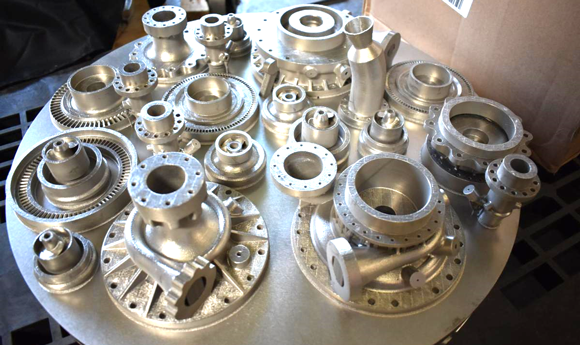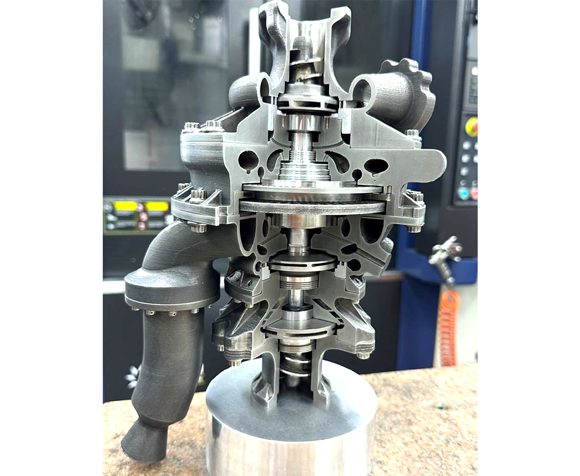Metal Additive Manufacturing enables undergraduates develop economical rocket turbopump concept
August 30, 2023

Two undergraduate students, Zachary Lesan and Patrick Watson, from the Aerospace Engineering Sciences programme at the University of Colorado Boulder, have collaborated with experts from CFTurbo, Velo3D, Silicon Valley Elite Manufacturing, EMP, and others to develop an economical and reliable rocket turbopump concept. During their field internships, the two formed relationships with senior designers from Space X and Launcher who helped them understand the pathways to solving the most pressing challenges surrounding rocket design and the creation of ideal, single-part, high-performance components for space.
Zach Lesan, the original lead on this college team of two, came up with the project idea in January 2021 during his junior year of undergraduate studies. Watson joined and took over most of the responsibilities towards the end of 2022, after Lesan had graduated and begun an internship at SpaceX.
“I started this project because I loved rockets and turbomachinery,” shared Lesan. “I knew how solid-state rocket motors worked and designed them in the past while in high school. However, liquid-propulsion rockets captured my imagination. I wanted very much to understand all the details.”
“I attacked the problem head-on,” Lesan added. “It was a huge opportunity to learn component design, complex assembly design, CAD, 3D-printing design principles, and a variety of software modelling solutions to first principles problems.”
Learning to solve engineering problems was an obvious benefit of the undertaking. However, the design and build process for the turbopump presented more challenges to overcome. The hardest, yet perhaps most rewarding, task was to collaborate with industry partners who could offer Additive Manufacturing, machining, off-the-shelf parts such as seals and fasteners, and advice. Typically, such efforts are handled by seasoned managers. However, Lesan and then Watson made acquiring partnerships a major element in moving support and production beyond the school-run manufacturing lab to more advanced industrial sites.

Industry collaboration
In the early stages of the project, Lesan aimed for single-part construction and contacted metal-AM provider Velo3D. He was aware that their Laser Beam Powder Bed Fusion (PBF-LB) build capabilities were crucial to the production of the SpaceX Raptor engine. This inquiry led to a conversation with Velo3D’s VP of Global Sales and Business Development, Zach Murphee, and Director of Technical Sales, Gene Miller. Both individuals encouraged Lesan and offered the company’s technology and services for the project.
“Zach and Gene were super excited about the project,” said Lesan. “And their excitement made me further committed. The design capabilities of the Velo3D printers and their personal encouragement ultimately drove me to go through the whole design process on the turbopump.”
After Lesan’s call to Velo3D, another breakthrough occurred. With the redesign of the turbopump underway, Lesan met Patrick Watson, who would soon become his co-designer, at the CU Sounding Rocket Laboratory (CUSRL). There, they discovered a shared interest in turbomachinery, and their joint venture began. “Zach [Lesan] showed me his engineering presentation, and I was blown away by how technically advanced it was,” said Watson.
“Patrick stepped in around the Christmas 2021 timeframe,” Lesan added. “I learned that he was working on turbomachinery through his internship at Launcher [a Vast company]. That set the stage for our collaboration right there. Patrick learned more and more about my initial design in early 2022, and then took over our project entirely that year in terms of getting parts made and working with partners. He carried on with the drawings, manufacturing documents, CFD and final deliverables.”
Reducing the cost of spaceflight
The past five years have seen significant advancements in space and rocket technology. Independent engineers and commercial companies alike are working towards designing single-part rockets and consolidating manufacturing approaches. The goal, shared by Lesan and Watson, is to reduce reliance on traditional machining, casting, brazing and joining techniques, which limit functional performance, decrease reliability, and depend on a dwindling supply chain.
“A lot of companies cast their parts,” said Watson. “The real big breakthrough in turbomachinery for space or energy is 3D metal printing, Laser Powder Bed Fusion (LBPF), mostly. We can now print the performance geometries we want, iterate the designs, get the surfaces we need, and use machining more selectively. Metal 3D printing makes our project possible. Zach and I used our intern salaries to fund what wasn’t donated or discounted. Imagine us spending tens of thousands of dollars on machining traditional parts or removing support structures.”
The academic objectives of the Reaper engine were to investigate agile and more cost-effective methods of manufacturing rockets. Lesan and Watson both recognised that the project’s success was dependant on the reduction of the cost of spaceflight.
Optimising the design with Additive Manufacturing
With his early studies in solid-state rockets as a teenager and so much data on turbopumps in hand since 1960s, Lesan had the basics in place for the design work he was to undertake at CU Boulder. His next step was to create his own MethaLOX model utilising metal AM. This was the only area where he felt he could make a unique contribution. While turbopumps were a known entity, Lesan did not expect to improve their performance. However, he believed that by incorporating AM, he and Watson could reduce costs and improve system reliability over existing methods.
Part consolidation improves quality by eliminating component sealing interfaces, a historic source of failure. Turbopumps have long relied on seals to join their sections. Despite advances in technology, seals remain a risk area due to the high fluid/gas pressures involved in the pump and turbine units.
“We have gotten rid of so many potential traditional failure modes by minimising part count,” said Lesan. “The issue then with AM is porosity and part verification. We can look at our Velo3D build reports and see there were no errors in the process impacting quality.”

“There are some parts we had to buy or conventionally manufacture,” said Watson. “The purchased parts are fittings, bearings, seals and fasteners to join flange sections. But otherwise, the focus was on creating a work-friendly, lower-cost system, that avoids traditional fit problems through combined parts. There is a safety issue here, too,” noted Watson. “The inner propellent seals, made as one part, is outside the norm. By using a nitrogen-purge system, that is integrally printed throughout the Reaper turbopump housings, we effectively eliminate the chances of propellants mixing and causing catastrophic failure. We are able to reduce leakage losses, avoid performance problems, and even explosions. A single AM-produced part, relying on challenging overhang angles and approaches, accomplishes this goal.”
A passion for space
Lesan and Watson were able to rapidly develop their rocket with the help of many individuals who share a passion for space. Among them were Professor John Farnsworth from the CU Boulder Aerospace program, as well as Cameron Micksch and Paul Wingrove from the university’s machining lab.
Private industry also provided software, services, parts and advice. The core team of two used Velo3D for their metal AM; critical design software and ongoing help from CFturbo; and machining services from Silicon Valley Elite Manufacturing and EMP. In addition, they received seals from Gallagher Fluid Seals and instrumentation from Kulite and Omega. Advice flowed informally from individual engineers at both their internship companies, SpaceX and Launcher, as well as from Ursa Major and Andrew Mitchell, formerly with Masten Space Systems and now with Astrobotic.
“The extent of industry collaboration that Zach and Patrick have created is truly impressive,” said Sid Raje, Velo3D business Development Account manager. “They have built upon where industry is headed with liquid oxygen and methane propulsion, but the extent of their use of advanced AM for part consolidation and demanding geometries, surfaces and overhangs really stands out. The reduction of post-processing costs and improved system reliability is a lesson they and others will carry forward.”
Lesan has concluded his industry internship at SpaceX and is now serving as a second lieutenant in the Space Force. Meanwhile, Watson is finishing the final leg of his undergraduate studies and has secured a job at Launcher Space. Many hands and minds will continue to work on completing the Reaper, with the goal of achieving a flight to the Karman line at 100 kilometers.
Download Metal AM magazine

















